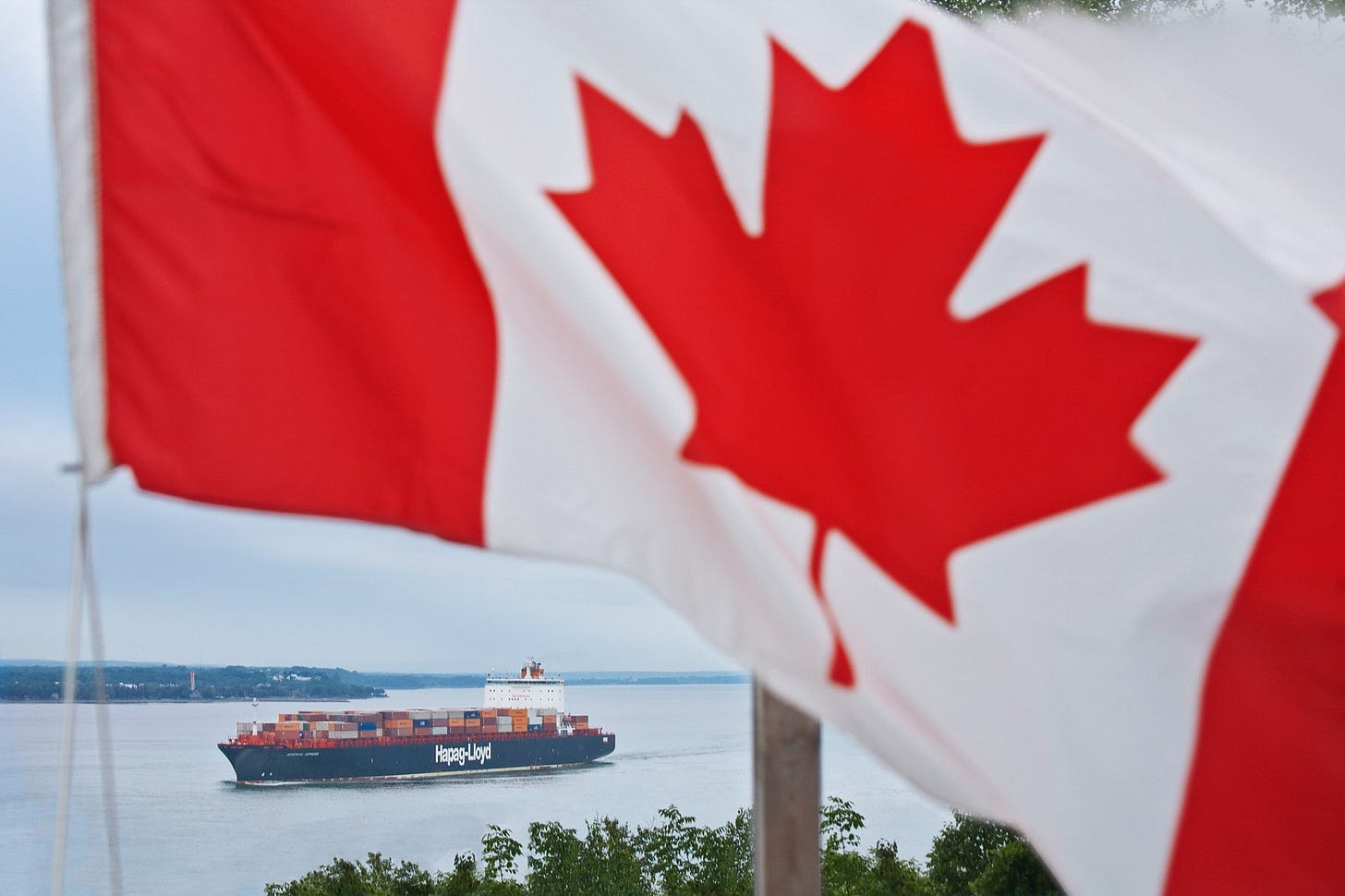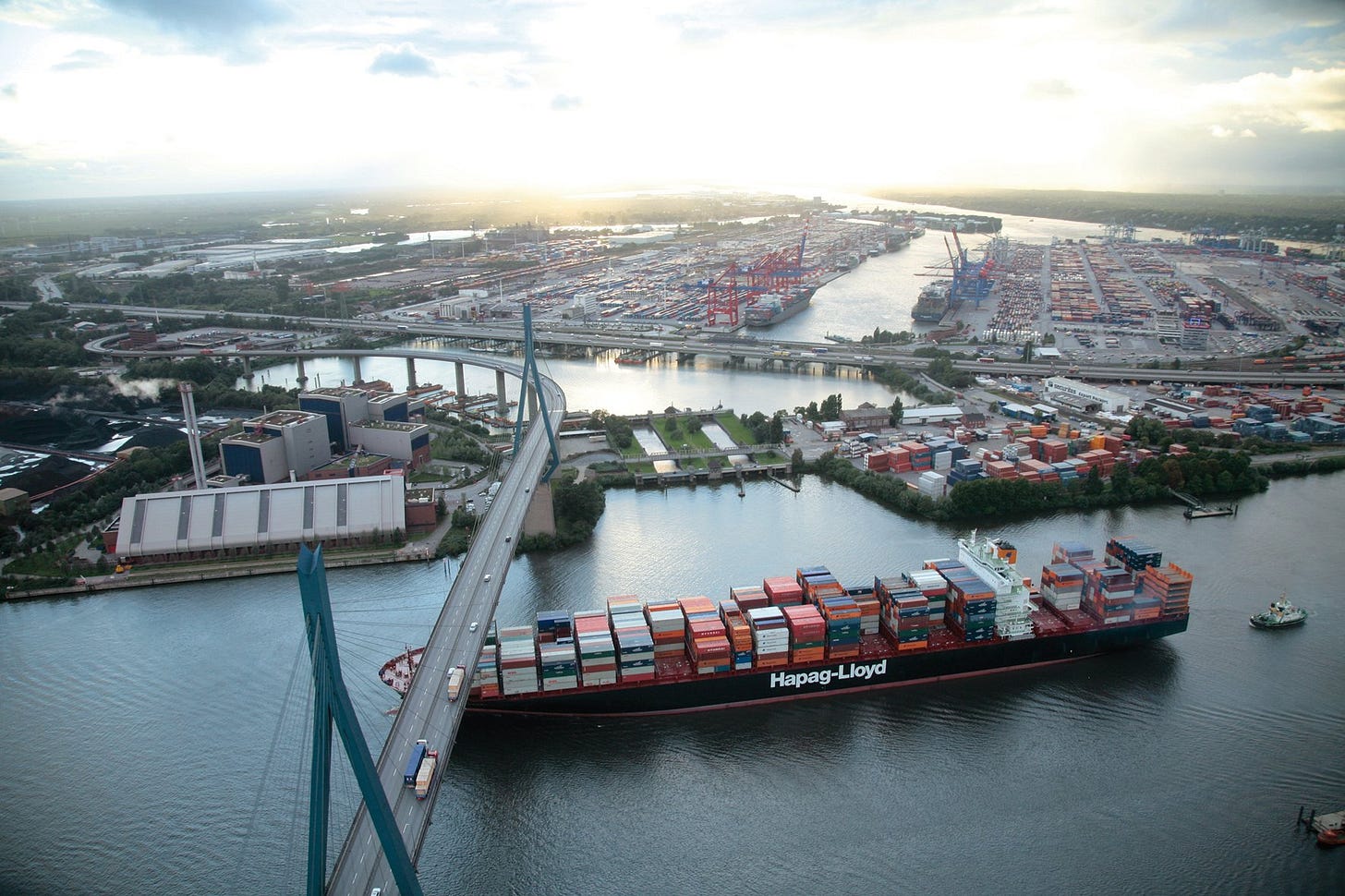Saint John’s Second Act: Building a Continental Trade Gateway
Global alliances, private investments, and cold chain innovations are transforming the Port of Saint John, but the real test will come inland.
Hello everyone! Lisa here. It’s Election Day in Canada, and I don’t know about you, but I’m ready to move past the campaign and get to work on our country’s next chapter. Gina and I are making a slight change to our publishing schedule; rather than run my piece about the very public debate about Saint John’s Wolostoq Park, we’re going to publish two pieces by Gina that explain Port Saint John’s ambitions and the impact all this seafaring will have on land, including the bottleneck at Simms Corner.
Also, a BIG thank you and welcome to our new subscribers. Thanks to you, Side Walks was trending as the 26th fastest-growing news publication on Substack last week! Pfft to everyone doomscrolling American news, Canada’s East Coast has got it going on! Thank you everyone!
If you’re just discovering us, please consider signing up as a free subscriber, and if you’re a free subscriber, please consider upgrading to a paid monthly or annual subscription to support our public service journalism.

When cranes swing over container ships at the Port of Saint John, they move more than steel boxes: they move the province closer to the centre of a ‘One Canadian Economy’ trade strategy.
However, the real transformation lies inland, where Saint John is building the connections that will define its future role in global trade.
For decades, Saint John has been a strong performer in dry and liquid bulk cargoes, anchored by the presence of the Irving oil refinery and shipments of commodities like potash and recycled metals. But its deepwater harbour and proximity to the US market were underutilised, constrained by aging infrastructure, limited container handling capacity, and the absence of direct service from major global shipping alliances. Until recently, annual container throughput remained below 60,000 TEUs1.
Things have changed. Saint John is positioning itself as an eastern gateway to a national and continental transportation corridor. Port Saint John’s new shipping partnerships, private investments, and expanded rail capabilities have allowed it to compete for cargo that once bypassed Atlantic Canada entirely.
These changes are coming together at a critical moment, as Canada seeks to rebalance its East-West trade orientation to enhance its economic resilience, and as Canadians go to the polls today at a momentous time for national pride and sovereignty.
While federal Liberals and Conservatives may differ on numerous issues, they are both focused on quickly executing an aggressive East-West reorientation of Canadian trade.

"Fundamentally, what's changed for Saint John is the scale at which we're participating. It used to be pretty local, some regional. Now we're seeing that Saint John is on a continental and even global stage when it comes to supply chains and routing decisions," says Craig Bell Estabrooks, CEO of Port Saint John.
Driving this transformation are several catalysts.
First, years of incremental growth through services by global shipping lines such as MSC, formerly the Mediterranean Shipping Company, founded in Belgium and today the largest carrier; Maersk, the Danish shipping giant and the second largest container carrier in the world, known for its deep integration into global logistics chains; CMA CGM, the French container shipping giant and the third largest carrier in the world; and Hapag-Lloyd, the German-based company that traces its roots back over a century and is the world’s fifth largest shipper.
Second, expanded inland connectivity through CPKC's rail network, formed by merger of Canadian-Pacific and Kansas City, which extends Port Saint John’s reach to Chicago, Kansas City, and deep into Mexico.
Third, operational investments by DP World that enhanced terminal efficiency. DP World is a global logistics company headquartered in Dubai, operating more than 80 marine and inland terminals worldwide.
Fourth, the arrival of Gemini Cooperation's direct container service and Atlanta-based Americold's cold storage facility, positioning the port to compete more aggressively in higher-value cargo segments. Gemini Cooperation is a new vessel-sharing alliance launched by Maersk and Hapag-Lloyd in 2025, focusing on high schedule reliability and a hub-and-spoke transatlantic network.
Side Walks is fully funded by readers and organizations that support our mission to produce local journalism. If you’re enjoying this story, please consider becoming a paid subscriber, $8/month or $80/year. You can also sign up for a free subscription. All subscriptions deliver Side Walks directly to your email inbox, and you can also read along on the Substack app.
Think of Gina and me as your friendly neighbourhood buskers setting fire to complacency while juggling a mix of coverage, commentary and culture – and this is the point in the show where we pass the hat. We appreciate your support!
Now back to the story…
A partnership rewritten: Public investment and private momentum
It’s rare that we celebrate the successful fusion of public and private investments, but Port of Saint John is a bona fide cause célèbre. In July 2016, the federal and provincial governments, along with the Port Saint John, announced a $205 million investment for the West Side Modernization Project. The funding was intended to revitalize the port's infrastructure, including deepening berths and enhancing intermodal facilities.
Consequently, DP World signed its 30-year lease agreement to operate the port's container terminal, with operations commencing in January 2017. DP World's involvement included commitments to upgrade terminal equipment and integrate the port into its global network, delivering the largest private sector investment in the port in decades.
Douglas Smith, CEO of DP World Canada, explained that the company's goal was not merely to manage Saint John's existing operations, but to build a new platform for growth, transforming the port from a regional feeder into a competitive Atlantic gateway.
The DP lease and the company’s ongoing investments in cranes, yard management systems, and terminal operating technologies has fundamentally altered the port’s capabilities and repositioned Saint John from a feeder terminal to an up-and-coming Atlantic gateway with the credibility needed to attract the Gemini Cooperation's major shipping lines Maersk and Hapag-Lloyd which launched in February 2025.
Smith emphasises that success in attracting major services requires more than infrastructure: "We have taken on all the stops to make sure we are part of that value proposition, that we are supporting them 100 per cent the best we can."
But ships and cranes alone do not secure a port's future. True competitiveness depends on what happens after the cargo touches shore.
The Americold Effect: Cold Chain Ambitions
The port’s credibility and its powerful new partners have attracted new players. In January, Americold Realty Trust announced plans to develop its first Canadian import-export hub at Port Saint John, New Brunswick.
This facility will be the first globally to integrate Americold's warehouse solutions with the maritime logistics capabilities of DP World and the rail logistics solutions of CPKC. Americold will invest between US$75 million and US$80 million to construct a 190,000-square-foot cold storage facility, providing approximately 22,000 pallet positions.
"Americold would not be in Saint John without DP World and CPKC. It just would never have happened," Bell Estabrooks notes.
Cold chain infrastructure would enable Saint John to export high-value goods like seafood, produce, and pharmaceuticals, which were previously out of reach. It is expected to be the only multi-tenant cold storage facility within a 100-kilometre radius.
The cranes and cold storage mark a beginning, not an end. Saint John’s future as a continental trade hub will be decided inland, across rail lines, industrial parks, and highways that must now move faster to meet the challenges of a renewed trade corridor.
Coming Up On Side Walks: Racing Inland – Saint John’s New Trade Frontier
Saint John's global partners and customers come with global-sized expectations for both the Port and the City that surrounds it. Can Saint John adapt to serve a global shipping model built around speed and predictability?
Other Stories in Our Series - Saint John at the Crossroads
Previous Stories You Might Enjoy
We’ve Got to Play our Game Canada: Don't let the big guns down south intimidate you; we've got some moves we can make to shift momentum our way.
Hello! Bonjour! New Routes Bring New Rules As We Look to European Markets: How Local SMEs Can Turn Compliance into A Competitive Edge in EU Markets.
Are We Scared Enough to Leap? Twenty years after ringing the alarm about New Brunswick's precarious economic state, I'm curious if President Donald Trump's tariff threats will be enough to drive big change in this small province.
Where in the World Can New Brunswick Go? To find new markets, we can start by following the lead of local sales pros who successfully sell newsprint to the world.
Where in the World is New Brunswick? Gasoline & medium oils bound for Maine and Massachusetts lead the way; lobsters and lumber trail behind in a province dependent on the U.S. for 90 per cent of its export market.
If you enjoyed this column, please share the love with others who you think would enjoy the conversation we’re having on Side Walks. We’re a Canadian media start-up building a community of fellow Canucks (and the people who love us) interested in finding common ground around complex issues by focusing on local repercussions and opportunities caused by national and global issues. We’re based in New Brunswick, on Canada’s East Coast. Cheers!
A TEU is the standard measure of units for container boxes. It is officially 20 feet long by 8 feet wide by 8.5 feet high and has a volume of about 33 cubic metres.


